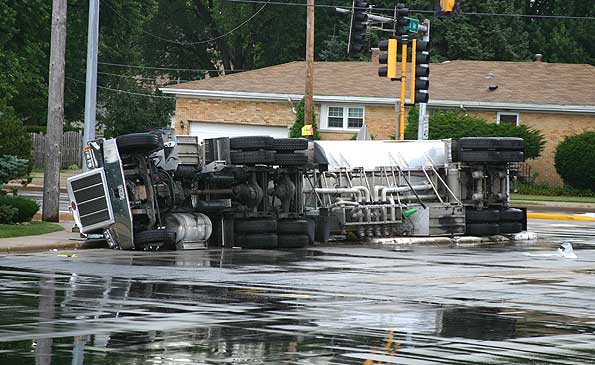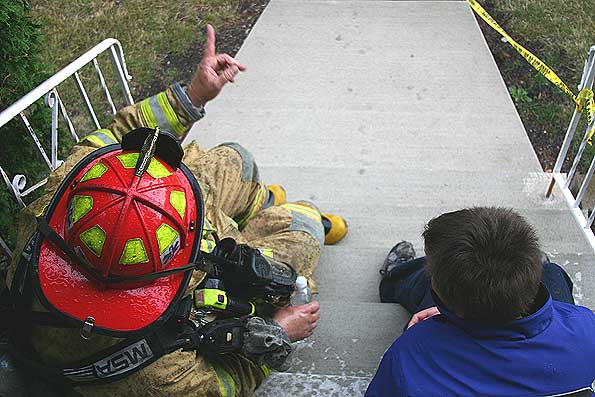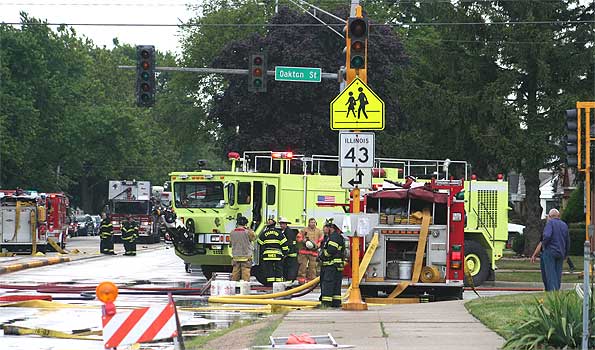
A gasoline tanker sits alone, but firefighters and environmental technicians are all surrounding the vehicle, planning how to safely offload gasoline to another tanker truck. The wet pavement is mostly water from a short rain after the rollover crash.

Taking a break and getting some shelter from the rain at about 10:00 a.m., a firefighter explains to a boy how they and the environmental hazmat crew technicians are going to clean up the accident.
Niles Fire Department managed a HAZMAT operation at Oakton and Harlem for a gasoline tanker that overturned at the northeast corner of the intersection. Fire command requested an urgent call for foam early this morning at the beginning of rush hour. Prospect Heights Fire Department’s Airport Crash Truck and Wheeling Fire Department’s Airport Crash truck were the first to respond to that request at about 7:20 a.m. No fire was reported as of 7:20 a.m., but the situation was dangerous as levels of gasoline and vapors near the accident scene were near explosive levels. Early reports at the scene indicated that there were about 7200 gallons of gasoline in the tanker. Chicago Fire Department responded with at least three fire suppression units and a Battalion Chief. One of O’Hare’s units that responded was Crash Tender 6-5-7.
There were no reports of any injuries to the driver of the truck. During a prolonged operation to absorb and clean gasoline from streets and underground seepage areas, one hazmat environmental technician, from a private firm was treated by paramedics. After a cool, rainy morning; the weather turned hot under sunny skies, which added the element of heat stress to firefighters, paramedics, environmental technicians and other workers. Niles Fire Department command called for additional engine crews and ambulances to assist or standby at the scene.
Traffic delays were expected to persist during the evening rush, but perhaps not as bad as the morning rush hour. At about 3:45 p.m. Nile Fire Department command started to release mutual aid companies from the scene after emptying the tanker truck of remaining gasoline.

Chicago Fire Department Airport Fire Supression Unit ‘Crash Tender’ from O’Hare International Airport — the crew working to prevent a gasoline tanker explosion and prepare for aggressive suppression in case of ignition of the tanker and gasoline.
Video shows operation of a hazmat technician drilling holes in the tanker, and the video shows firefighters in protective gear standing by if any fire occurred. The video also shows the paramedics treating one the injured environmental technicians.
Residents were evacuated along streets just east of the accident scene and from five houses just west of the accident. Residents were offered rest and support at the Niles Senior Center.
Com Ed cut electricity to neighborhoods in the vicinity to de-energize the electric lines and stoplights near the accident scene. A spark at an electric switch or an arc in a power line could have caused a massive explosion and fire. As firefighter’s and Com Ed workers took care of regulated electricity, fire scene commanders were kept aware of the sky by Red Center Dispatch Center who monitored a small electrical storm that passed just north of the accident scene at Harlem and Oakton. A lightning strike or the downing of power lines from the high winds of a thunderstorm could also have ignited the leaking tanker truck.
SET Environmental, the Metropolitan Water Reclamation District of Greater Chicago, and the EPA were also on the scene.
The truck was leaking gasoline, but the drain-off was held by sand dikes. Some gasoline did make it to the sewer system. Dikes and absorbent material kept the gasoline from traveling downstream to Chicago in the Chicago River. A team of workers set up absorbent material at the river near Howard Street. Teams also constantly monitored for occurrence of gasoline and for explosive levels of gasoline vapors. Drainage under the streets near the crash site were flushed with water and the water was then vacuumed into another tanker truck.
Gasoline also made its way into at least one underground traffic light control vault. A strong odor of gasoline was in the air immediately after the accident, but by 8:00 a.m. the leak was stopped at the truck, and firefighters were faced with the task of preventing an explosion, getting environmental help for cleanup, and getting help to offload the fuel from one tanker truck to another. The tanker truck had four sections with different grades of gasoline. Only one section was damaged, and it was the only compartment leaking from the crash damage.
The tanker crash is under investigation. Ambulances from Lincolnwood, Morton Grove, and Wilmette fire departments assisted Niles Fire Department. Fire department crews from Chicago, Des Plaines, Lincolnwood, Morton Grove, Mount Prospect, Park Ridge, Prospect Heights, Skokie, Wheeling, and others assisted Niles Fire Department for the HAZMAT Box Alarm at Harlem and Oakton.

This is what I call a very dangerous job for firefighters and people involved in the accident to prevent safety to others! It was a miracle that there was no gasoline explosion!
On the first picture is that a gasoline on the street?
PLEASE GOOGLE “DEFORMABLE KINGPIN” that explains a simple to understand solution to forbid a tractor to follow into destruction during rollover events. The concept is the same as to why you have fuses or circuit breakers in electrical systems in your home, office or car — a failsafe — to prevent further destruction. This innovation is a simple modification of a component, the trailer’s coupling kingpin, whose design has been a standard for over 70 years, which can be made to deform and not allow an extremely stable tractor to follow to destruction when the trailer, that is the dominant controlling force, is in IMMINENT peril for rollover, that includes also blown over tractor trailers. The NHTSA & FMCSA continue to turn their backs and ignore their past funded research conclusions, as the trucking industry evolves greater unstable tractor trailers on our highways that have a primary attribute for increasing payload capacity. These catastrophes will continue to occur in thousands of accidents of this type each year as they have in the past, and continue to cause infrastructure damage that will harm and kill many hundreds of tractor occupants annually. These combination vehicles are incendiary bombs when carrying flammable material in tankers, and the flash point for these fires starts with the tractor’s involvement. A statement received from the FMCSA states “There are a variety of technologies for preventing rollover crashes and we believe motor carriers should have as much flexibility as possible in selecting technologies to prevent crashes.” Clearly the fox is allowed to guard the hen house!!! The harm, death & destruction will continue with combination vehicle rollover accidents. Donald J. Kaleta